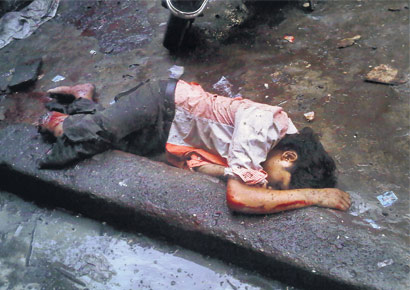 |
| The controversial photograph |
Many readers were shocked to see the front-page picture splashed by my paper. Yes, it was gory. As the page was being made, I was wary of the impact it might have. Indeed it might have spoilt several people’s mornings. But was it a good morning of yours that we spoilt?
Let’s face it. There were serial blasts in the city, nearly two dozen people were killed and hundreds injured. How do we put it across to you? How do we sanitise the truth for you?
It reminded me of a conversation I had with Israeli security experts who were in the city after a spate of bombings a few years ago (there have been so many, I can’t recall exactly which one). They were of the opinion that the media should not bring such images to the people. “By putting blood on the front pages, you play into the hands of the terrorists,” one of them argued. “That’s the effect they want — spread fear.”
Article continues below the advertisement...
Be calm, the prime minister tells us. Our erudite home minister P Chidambaram wants the media to behave. Oh please, don’t tell us what to do. Do what YOU are supposed to do. If the PM had been acting and Chidambaram’s boys had been doing their jobs, we wouldn’t have had the blasts in the first place.
Coming back to the goriness of the picture: did we exaggerate? Did we sensationalise? Did we morph the picture to magnify the effect? Okay, it did not go with the warning that India Today ran when it put on its front page the mangled remains of Rajiv Gandhi way back in 1991, after a suicide bomber blew up our former prime minister. Or that series of pictures that The Times of India ran on its front page after then president Shankar Dayal Sharma tripped and fell. Many felt it was a mere accident and the newspaper should have refrained from mocking the president.
Well, it was a call the newspaper’s editors made. Just like the call the British media took (or were forced to take) after the London bombings of July 7, 2005. The pictures were controlled — an injured woman covering her bloodied face with a mask and a top view of a mangled bus. I am not sure the UK government had any role to play in it.
As far as we are concerned, we had a job to do, and it was to bring to you the true severity of the blasts. We did it. And, apparently, we succeeded.


No comments:
Post a Comment